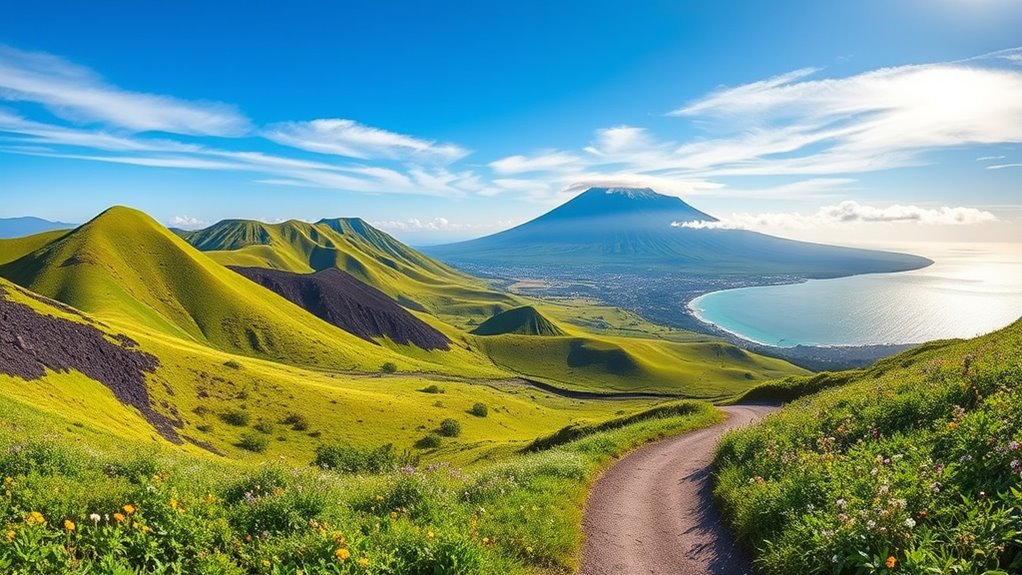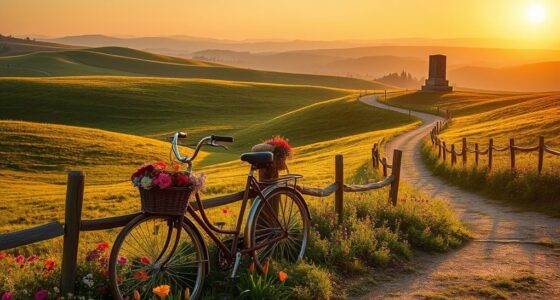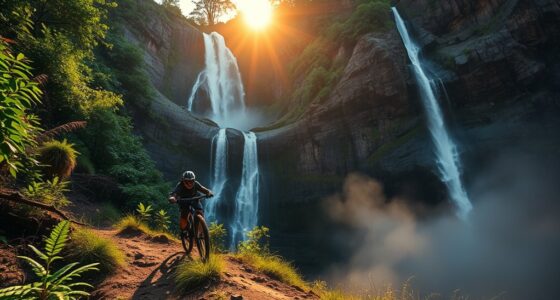Pedal through Jeju Island for an unforgettable adventure! You’ll experience stunning volcanic landscapes, including the majestic Hallasan National Park and the picturesque Gotjawal forests. The 234-kilometer cycling routes take you along the coastline, revealing breathtaking views and iconic landmarks like Seongsan Ilchulbong. Don’t miss the chance to taste the delicious local oranges and explore the unique Haenyeo culture. There’s so much more to discover about this incredible island.
Key Takeaways
- Explore Hallasan National Park’s stunning volcanic landscapes and diverse ecosystems while cycling on scenic paths.
- Experience breathtaking views along the 234-kilometer cycling route, connecting beaches and geological wonders.
- Ride the Coastal Road for picturesque vistas, especially at Seongsan Ilchulbong during sunrise and the scenic Shinchang Windmill Coastal Road.
- Discover Jeju’s unique volcanic features, including the Geomunoreum Lava Tube System and Jeonbang Falls cascading into the sea.
- Enjoy the island’s rich agricultural landscape, with opportunities to taste famous Jeju oranges while cycling through vibrant orchards.
Discovering Jeju Island’s Volcanic Origins
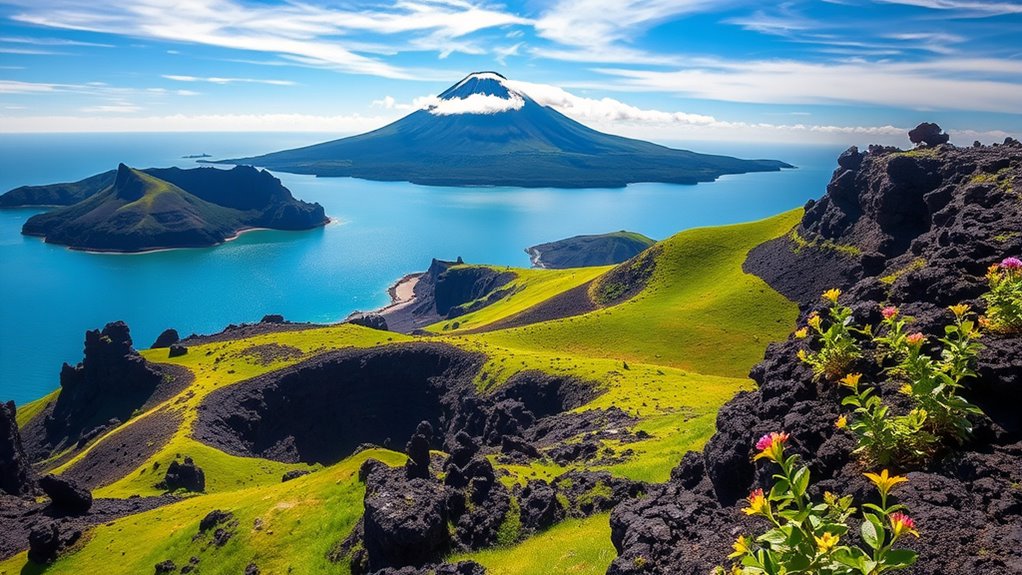
Have you ever wondered how Jeju Island came to be? This stunning destination formed through volcanic activity between 1.2 million and 250,000 years ago, evolving over four distinct stages.
You’ll notice that the island’s landscape is dominated by basalt, a dark volcanic rock covering more than 90% of its area. Jeju’s unique features include Mt. Halla, the tallest mountain in South Korea, and 368 parasitic cones, the highest concentration globally. The island is also home to around 360 cinder cones, primarily formed from basaltic lava flows that contribute to its remarkable geological diversity.
Historical eruptions, like those in 1002 and 1007 AD, have shaped its geological narrative. Exploring Jeju is like wandering through a natural museum, offering you invaluable insight into the planet’s volcanic history and the powerful forces that crafted this breathtaking island.
Cycling Through Hallasan National Park
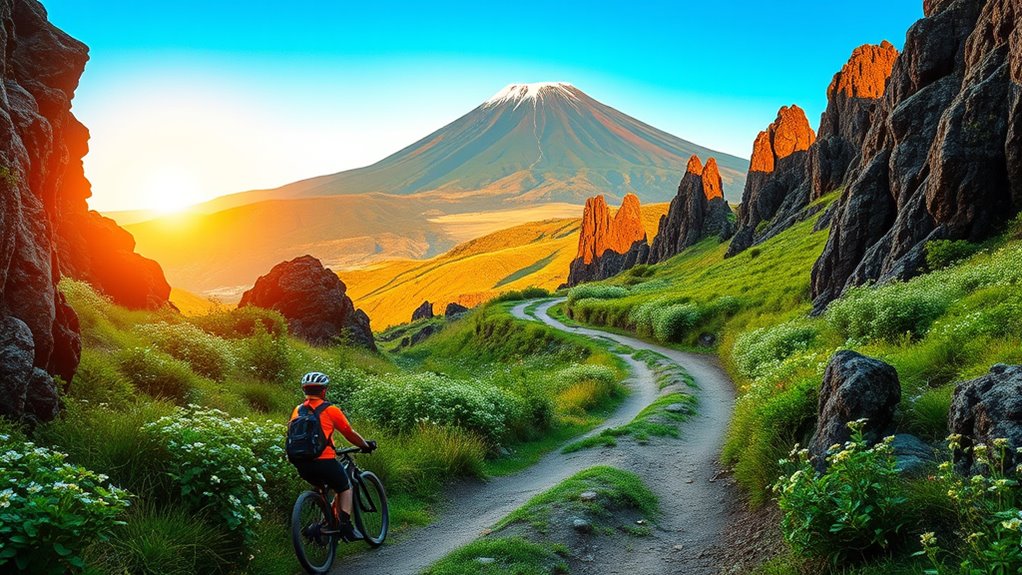
Exploring Hallasan National Park by bike offers an exhilarating way to appreciate the island’s stunning landscapes and volcanic features. While the park itself lacks dedicated bike paths, the Jeju Fantasy Cycling Path runs nearby, providing access to breathtaking views of Hallasan and the surrounding terrain. This 234-kilometer route meanders along Jeju’s perimeter, showcasing beaches, resorts, and unique geological sights. The highest peak in South Korea adds to the dramatic backdrop, making your cycling journey even more memorable. Prepare for varying terrain, including hills and narrow shoulders, which require moderate fitness and road awareness. Combine your cycling adventure with hikes on popular trails like Seongpanak or Gwaneumsa for a full experience. Don’t forget your helmet and water bottle to stay safe and hydrated while you soak in Jeju’s natural beauty!
Scenic Routes Along the Coastline

As you drive along Jeju’s scenic coastal routes, the breathtaking ocean views and unique landscapes unfold before you, creating an unforgettable experience.
The Coastal Road connects the island’s east and west sides, showcasing stunning vistas. Don’t miss the Woljeong-ri Coastal Road, famous for its picturesque sunsets, or the Shinchang Windmill Coastal Road, where offshore wind farms complement the scenery.
Aewol Coastal Road zigzags along the cliffs, while Jungsangan Road offers mountainous backdrops.
Stop at attractions like Seongsan Ilchulbong for sunrise, or explore the volcanic formations at Yongmeori Coast.
With narrow roads and sharp turns, remember to drive carefully and take breaks to soak in the beauty surrounding you. Enjoy every moment of this coastal adventure!
Exploring the Unique Gotjawal Forests
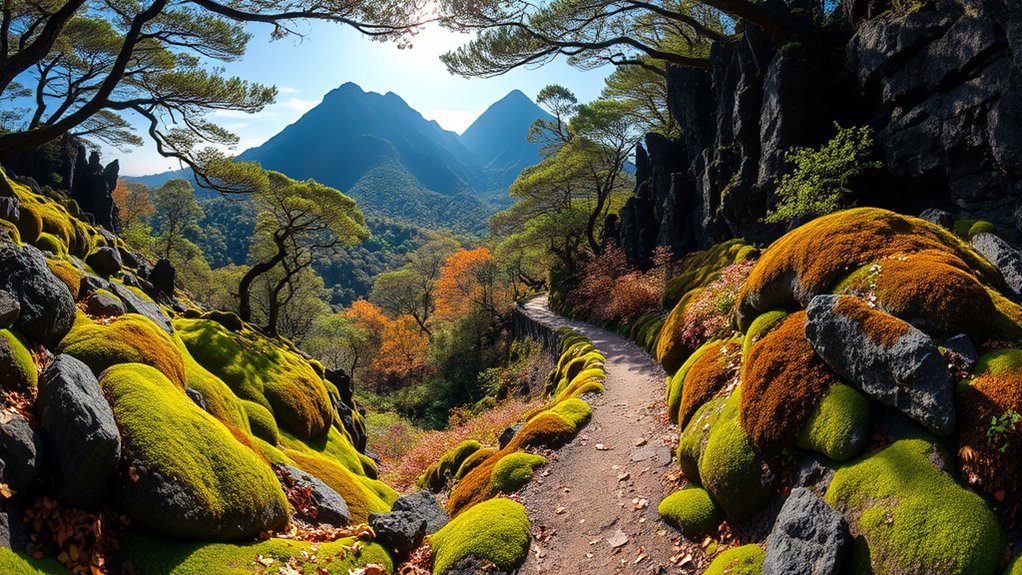
What makes the Gotjawal forests of Jeju Island so captivating? These unique ecosystems, scattered along the island’s east-west axis, cover about 109 square kilometers of volcanic rock.
You’ll discover over 750 plant species, including rare ferns and ancient camellia trees. The porous terrain, formed from cooled lava, creates small holes that circulate air and regulate humidity, contributing to a stable environment for wildlife. The gotjawal ecosystem features a unique life cycle where weak trees evolve into thorny bushes for protection.
Keep an eye out for eastern roe deer and various migrating birds as you explore. Government protection and initiatives by the Gotjawal Trust aim to preserve these vital habitats against urban development.
Guided tours through Hwansang Forest Gotjawal Park will deepen your appreciation of this ecological wonder, ensuring you won’t forget your experience.
Iconic Landmarks: Seongsan Ilchulbong and More
Jeju Island boasts several iconic landmarks that showcase its stunning volcanic landscape and rich cultural heritage.
One must-visit site is Seongsan Ilchulbong, or Sunrise Peak, a UNESCO World Heritage Site that rises 180 meters above sea level. The breathtaking sunrise views make the hike to the top a memorable experience. Additionally, Seongsan Ilchulbong is important for studying Surtseyan-type volcanic eruptions, offering insights into volcanic activity.
Seongsan Ilchulbong, a UNESCO World Heritage Site, offers unforgettable sunrise views and a rewarding hike to its summit.
Don’t miss the Geomunoreum Lava Tube System, known for its multicolored carbonate decorations and dark lava walls, offering a glimpse into volcanic processes.
Mount Halla, the highest peak in South Korea at 1,947 meters, features hiking trails that reward you with panoramic views. It is also home to diverse rock formations and high biodiversity, making it a significant natural area.
With over 360 volcanic hills, known as oreum, Jeju’s landscape is a treasure trove of unique natural wonders waiting to be explored.
Cultural Experiences in Seongeup Folk Village
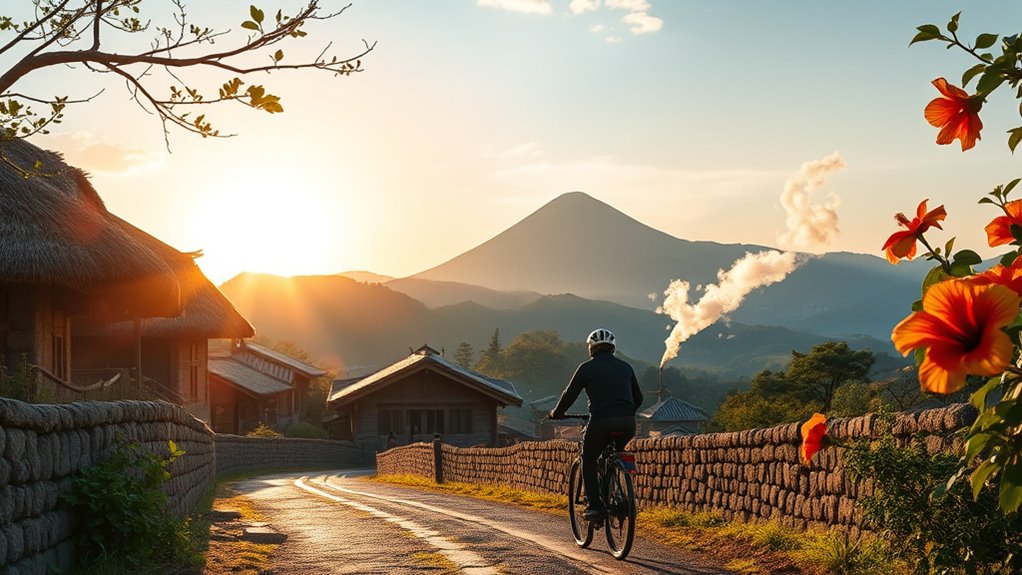
At Seongeup Folk Village, you’ll step back in time to experience the rich cultural heritage of Jeju Island. Nestled at the foot of Halla Mountain, the village features traditional thatched-roof houses, unique black lava rock walls, and historical buildings like Confucian shrines and ancient government offices. The village also showcases cultural properties that have been preserved through generations, highlighting its historical significance.
As you wander through curvy alleys, you’ll encounter stone grandfather statues and centuries-old trees, all part of the village’s charm. Engage with the local culture by tasting native foods, exploring traditional farming practices, and witnessing folk plays.
With free admission and guided tours available, you’ll easily immerse yourself in the matriarchal society and vibrant lifestyle of the villagers. So grab your camera and take in the stunning sights!
Enjoying Freshwater Springs and Waterfalls

As you explore the stunning landscapes of Jeju Island, you’ll discover the refreshing allure of its freshwater springs and waterfalls. Formed from the island’s unique volcanic geology, these mineral-rich springs offer pure, healthful water cherished by locals for drinking and cooking. Notable spots like Donnaeko Spring and Saryeoni Forest Spring provide cool, serene experiences, perfect for hikers seeking tranquility. Additionally, visiting the Sanbangsan Mountain Carbonate Hot Springs allows you to soak in therapeutic waters enriched with natural minerals believed to have healing properties. Don’t miss Jeonbang Falls, the only waterfall in Asia that cascades directly into the sea, offering breathtaking views. Many sites are easily accessible via hiking trails, making your adventure convenient. With ongoing conservation efforts, you can appreciate the ecological and cultural significance while enjoying the natural beauty that defines Jeju Island.
The Vibrant Local Agriculture: Jeju Oranges
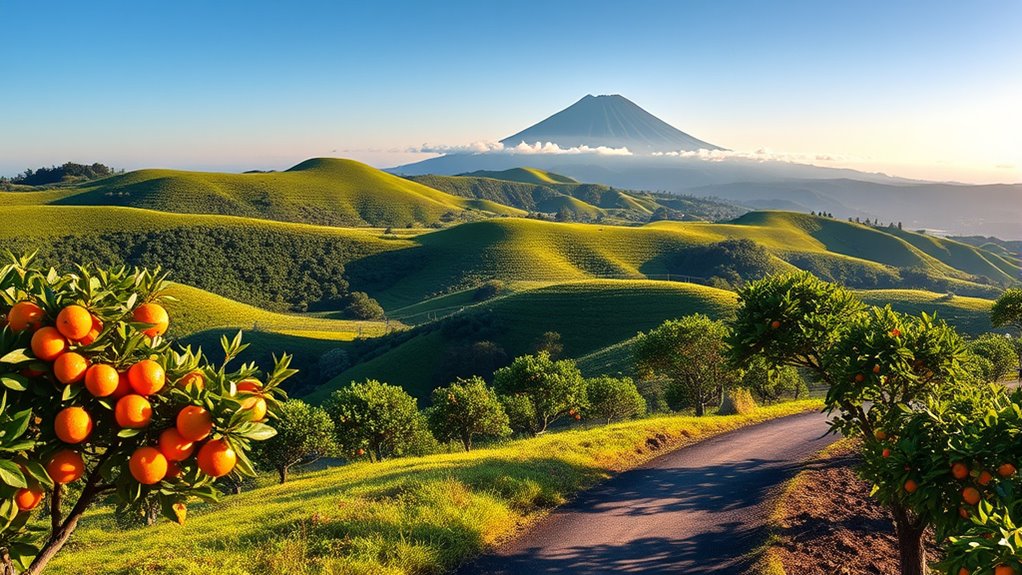
The lush landscapes of Jeju Island aren’t just defined by its stunning waterfalls and springs; they’re also enriched by the vibrant agriculture that thrives here, especially its famous oranges.
Jeju oranges account for a significant 55.8% of the island’s agricultural revenue, generating a whopping 1.32 trillion won in 2023. These mandarins are more than just fruit; they symbolize health and wealth, often exchanged as gifts during celebrations. Biodiversity hotspots such as Jeju Island support a variety of plant and animal species, which enhances the agricultural landscape.
While production in the Seogwipo region faces challenges from climate change, innovative farming practices are helping stabilize yields. Additionally, the island’s unique volcanic landscape contributes to the rich soil that enhances the flavor of these citrus fruits.
The Jeju citrus expo showcases the island’s commitment to climate resilience and varietal development, ensuring that these beloved oranges continue to flourish, even amid changing environmental conditions.
Embracing the Haenyeo Culture

Embracing the haenyeo culture offers a unique glimpse into the resilience and strength of women who’ve shaped Jeju Island’s identity for centuries. These remarkable divers, who began their journey as young girls, have transformed their community’s economy and social structure. With an impressive ability to dive up to 20 meters, they rely on breath-holding techniques to gather seafood without mechanical aids. After approximately seven years of training, a girl is recognized as a full-fledged haenyeo, showcasing the dedication and skill required for this traditional profession.
As a semi-matriarchal society, haenyeo play a pivotal role, often leading households and reversing traditional gender roles. Their cooperation in managing fishing grounds through cooperatives highlights their commitment to sustainability. Recognized by UNESCO as an Intangible Cultural Heritage, the haenyeo culture not only preserves a unique way of life but also continues to inspire future generations with its legacy of strength and community.
Navigating Jeju: Transportation Options for Cyclists
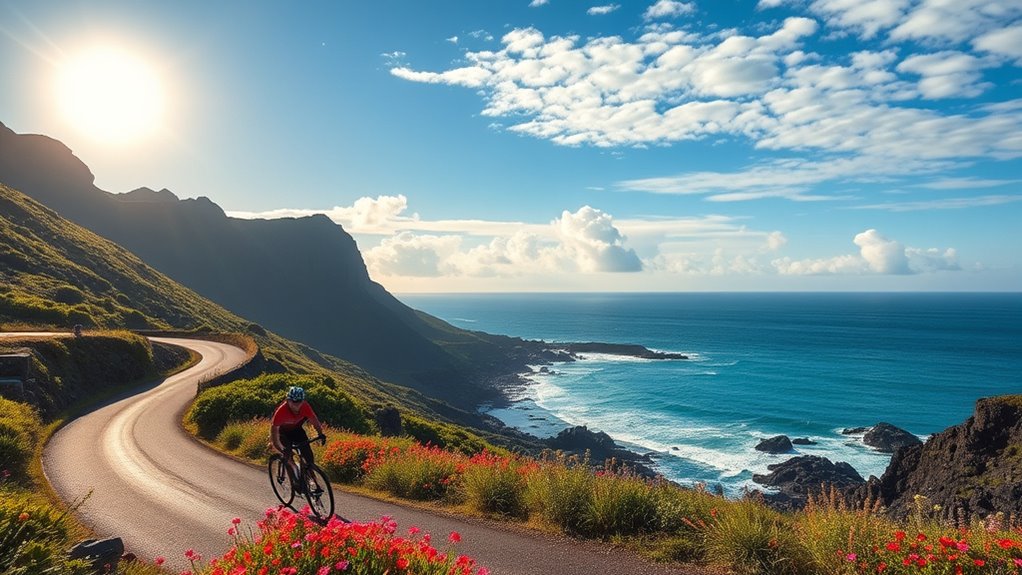
Exploring Jeju Island by bike allows you to fully appreciate its stunning landscapes, from volcanic views to serene coastlines. To get to Jeju, consider taking a ferry from Busan or Mokpo; the latter’s journey is quicker, taking only 2.5 to 4.5 hours. You can easily load your bike into the cargo hold, but remember to book in advance, especially during holidays. Additionally, ferry from Mokpo is the preferred option for a shorter travel time.
Once on the island, you’ll find well-developed cycle paths, like the Fantasy Bicycle Trail, that make riding enjoyable. Many roads feature dedicated bike lanes, ensuring your safety. Use Naver Maps to navigate the routes, and don’t forget to plan your accommodations in advance—there are plenty of options from guesthouses to cycling hostels along your journey.
Frequently Asked Questions
What Is the Best Time to Visit Jeju Island for Cycling?
The best time to visit Jeju Island for cycling is during spring or autumn.
You’ll enjoy mild temperatures, making it perfect for long rides.
Spring offers blooming landscapes, while autumn provides stunning fall colors.
Both seasons have fewer crowds, allowing you to fully appreciate the scenery.
Although summer’s sunny, it can be hot and humid, while winter isn’t ideal due to potential snow.
Plan your trip during these seasons for the ultimate cycling experience!
Are There Bike Rental Services Available on Jeju Island?
Yes, there are plenty of bike rental services available on Jeju Island.
You can choose from options like Bike Trip, Trazy, and Samcheolli, all offering various types of bikes, including mountain and electric bikes.
Rental prices typically range from ₩24,000 to ₩29,000 per day.
Most places include helmets and locks, making it easy for you to hop on and explore the island’s stunning landscapes at your own pace.
Can I Find Accommodations Near Cycling Routes?
Yes, you can definitely find accommodations near cycling routes in Jeju.
Many hotels, guesthouses, and minbaks are strategically located along popular paths, making it convenient for cyclists.
In rural areas and along the coastal routes, you’ll discover options that cater to your needs.
It’s a good idea to plan your route ahead of time so you can ensure there’s a place to stay each night after your ride.
What Safety Measures Should Cyclists Follow on Jeju Island?
When cycling on Jeju Island, you need to prioritize safety. Always wear a helmet and bright clothing for visibility.
Equip your bike with front and rear lights if you’re riding in the evening. Stay aware of your surroundings by avoiding earphones.
Follow traffic rules by riding with the flow, using bike lanes, and signaling at intersections.
Keep an eye out for obstacles on paths, and take regular breaks to stay hydrated.
Are There Guided Cycling Tours Available on the Island?
Yes, there are guided cycling tours available on Jeju Island.
Companies like Teamax Adventure and Core Travel offer flexible tour options, ranging from a few days to a week.
You’ll cycle along scenic coastal roads and explore volcanic landscapes while enjoying local culture.
Most tours include accommodation, meals, and bike rentals, ensuring a comfortable experience.
Plus, experienced guides provide valuable insights, making your adventure both enjoyable and informative.
Conclusion
Pedaling through Jeju Island, you’ll uncover its breathtaking volcanic landscapes and unique culture. From the stunning heights of Hallasan to the coastal paths and vibrant farms, every turn reveals something new. Don’t forget to immerse yourself in the rich traditions of the Haenyeo and savor the delicious local oranges. As you navigate this island paradise, you’ll create unforgettable memories that’ll inspire you to return again and again. So grab your bike and hit the trails!
